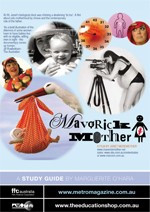Product Overview
Overview
I Am Mother is a sci-fi thriller set in a post-apocalyptic world where the human race lies on the edge of extinction and a teenage girl is raised by a maternal robot designed to repopulate the world.
The film explores the human relationship with technology, raising questions about a future in which machines driven by artificial intelligence outgrow the very people who created them.
Curriculum Links
I Am Mother would be suitable for middle and upper secondary students of English and Media Studies.
The film may also be used as a supplementary text in the teaching of Technologies curriculum, both in the Design and Technologies and the Digital Technologies areas, to promote discussion about 'preferred future' and the nature, impact and ethics associated with technological change. In addition, it can help develop the Australian Curriculum general capabilities (specifically, Ethical Understanding).
Specific links to the English curriculum:
I Am Mother relates to the following Years 9 and 10 English content descriptions of the Australian Curriculum:
Year 9
• Understand that authors innovate with text structures and language for specific purposes and effects (ACELA1553)
• Analyse and explain the use of symbols, icons and myth in still and moving images and how these augment meaning (ACELA1560)
• Explore and reflect on personal understanding of the world and significant human experience gained from interpreting various representations of life matters in texts (ACELT1635)
• Analyse texts from familiar and unfamiliar contexts, and discuss and evaluate their content and the appeal of an individual author's literary style (ACELT1636)
• Analyse how the construction and interpretation of texts, including media texts, can be influenced by cultural perspectives and other texts (ACELY1739)
Year 10
• Compare the purposes, text structures and language features of traditional and contemporary texts in different media (ACELA1566)
• Evaluate the impact on audiences of different choices in the representation of still and moving images (ACELA1572)
• Analyse and explain how text structures, language features and visual features of texts and the context in which texts are experienced may influence audience response (ACELT1641)
• Evaluate the social, moral and ethical positions represented in texts (ACELT1812)
• Analyse and evaluate how people, cultures, places, events, objects and concepts are represented in texts, including media texts, through language, structural and/or visual choices (ACELY1749)
• Identify and analyse implicit or explicit values, beliefs and assumptions in texts and how these are influenced by purposes and likely audiences (ACELY1752)
At senior secondary level (generally Years 11 and 12) students of English engage with texts to develop the ability to appreciate the purpose, stylistic qualities and conventions of literary and non-literary texts. They have opportunities to reflect on features of imaginative fiction texts, which include:
• Explaining the ways text structures, language features and stylistic choices are used in different types of texts (ACEEN005)
• Evaluating the impact of description and imagery, including figurative language, and still and moving images in digital and multimodal texts (ACEEN007)
• Analysing the style and structure of texts including digital texts (ACEEN022)
• Analysing the effects of using multimodal and digital conventions such as navigation, sound and image (ACEEN026)
• Analysing how attitude and mood are created, for example, through the use of humour in satire and parody (ACEEN027)
• Analysing the values and attitudes expressed in texts (ACEEN038)
• Evaluating the effectiveness of texts in representing ideas, attitudes and voices (ACEEN039)
• Explaining how and why texts position readers and viewers (ACEEN040)
• Analysing language, structural and stylistic choices (ACEEN041)
• Explaining how each text conforms to or challenges the conventions of particular genres or modes such as crime fiction, advertising or short films (ACEEN042)
• Analysing the techniques and conventions used in different genres, mediums and modes (ACEEN044)
• Undertaking close analysis of texts (ACEEN060)
• Questioning the assumptions and values in texts (ACEEN077)
Links to the Arts (Media) curriculum:
In Media Arts, students refine and extend their understanding of structure, intent, character, settings, points of view, genre and conventions through opportunities to reflect on, analyse, interpret and evaluate a range of media texts. Specifically, students:
• Evaluate how technical and symbolic elements are manipulated in media artworks to create and challenge representations framed by media conventions, social beliefs and values for a range of audiences (ACAMAR078)
• Analyse a range of media artworks from contemporary and past times to explore differing viewpoints and enrich their media arts making, starting with Australian media artworks, including media artworks of Aboriginal and Torres Strait Islander Peoples, and international media artworks (ACAMAR079)







